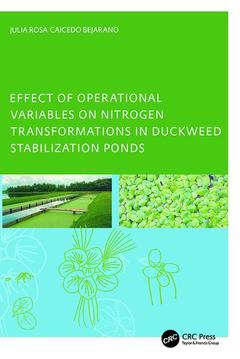Description
Effect of Operational Variables on Nitrogen Transformations in Duckweed Stabilization Ponds
Author: Bejarano Julia Rosa Caicedo
Language: English
Subjects for Effect of Operational Variables on Nitrogen...:
Effect of Operational Variables on Nitrogen Transformations in Duckweed Stabilization Ponds
Publication date: 06-2017
· 15.6x23.4 cm · Hardback
Publication date: 06-2017
· 15.6x23.4 cm · Hardback
105.47 €
Subject to availability at the publisher.
Add to cart
Effect of operational variables on nitro gen transformations in duckweed stabiliz ation ponds
Publication date: 03-2005
176 p. · 15.6x23.4 cm · Hardback
Publication date: 03-2005
176 p. · 15.6x23.4 cm · Hardback
Description
/li>Contents
/li>Readership
/li>Biography
/li>
There is an urgent need to develop and improve low cost technologies for wastewater treatment. Simultaneously treating wastewater and producing duckweed in a pond system is, therefore, an attractive solution contributing to both environmental protection and food production. Duckweed has excellent qualities: a high protein content, a high growth rate and is an easy crop to handle. The small plant turns nitrogen from wastewater into a food source. This thesis reports on the effect of different operational variables, like anaerobic pre-treatment, the combination of algae and duckweed ponds and pond depth. Improved nitrogen removal was obtained through the combination of duckweed ponds with algae ponds. Duckweed pond systems could be designed with shallow depth without affecting nitrogen removal efficiency. This research is the result of the cooperative effort between the EIDENAR, Univalle, Cali, Colombia and the UNESCO-IHE Institute for Water Education in Delft, the Netherlands.
1.Introduction 2.Effect of anaerobic pre-treatment on environmental physicochemicalcharacteristics of duckweed stabilization ponds. 3. Effect of total ammonia nitrogen concentration and pH on growth rates of duckweed 4. The effect of anaerobic pre-treatment performance ofduckweed 5.Nitrogen balance of duckweed covered sewagestabilization ponds. 6. The effect of introducing aerobic zones into a series of duckweed stabilization ponds on nitrification and denitrification. 7. Effect of pond depth on removal of nitrogen in duckweed stabilization ponds. 8.Comparison of performance of full scale duckweed and algae stabilization ponds. 9. Summary 10.Conclusion
Postgraduate and Professional
Julia Rosa Caicedo Bejarano
© 2024 LAVOISIER S.A.S.




